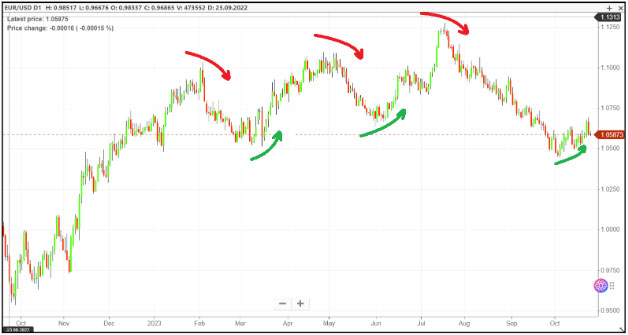In the varied world of financial markets, traders often ask which trading strategy will maximize their profits. One approach that has gained significant popularity over the years is swing trading.
Swing trading is a style that aims to capitalize on short to medium-term price movements, providing traders with an opportunity to profit from both upswings and downswings.
But is swing trading profitable? Let’s take a look.
Understanding Swing Trading
First, let’s start with defining what swing trading is. Swing trading is about identifying trends and looking to profit from short to medium-term price fluctuations or “swings”.

Unlike day trading, which involves opening and closing positions within a single trading session, swing traders hold their positions for a few days to several weeks. This approach allows traders to capitalize on price swings while avoiding the emotional stress associated with day trading.
Why Swing Trading Appeals to Many
Swing trading has several characteristics that make it appealing to traders of all levels of experience:
Pros of Swing Trading
Flexibility: One of the most significant advantages of swing trading is its flexibility. Traders do not need to be tied to their screens all day, making it suitable for those with busy schedules. For example, swing trading on the daily timeframe can be done by checking the charts for trades at the end of the day.

Risk Management: Swing traders can employ more relaxed stop-loss orders due to their longer holding periods, allowing for better risk management and improved risk-to-reward ratios.
Diverse Markets: Swing trading can be applied to various markets, such as stocks, forex, commodities, and cryptocurrencies, providing traders with a wide array of trading opportunities and adding diversification, a useful risk management strategy.
Technical Analysis: Swing traders rely heavily on technical analysis, using indicators, chart patterns, and historical price data to identify potential entry and exit points. With the right software, indicators and coaching, this analysis can be simplified to identify swing trade opportunities.
Cons of Swing Trading
Overnight Risks: Holding positions overnight exposes traders to risks associated with market gaps and unexpected news events that can impact their positions. Depending on your broker and the type of position you have, you may also have overnight funding charges that will be applied to your account.
Psychological Challenges: Swing trading requires discipline and emotional control. The temptation to exit or enter positions prematurely can be challenging for some traders.
Market Timing: Accurate market timing is crucial in swing trading. Entering a trade at the right moment can be difficult, and mistimed entries may result in losses. With the right indicators and signals, you can improve your chances of getting good entry and exit points.
Educational Requirement: Swing trading demands a solid understanding of market dynamics and technical analysis. Novice traders may need to invest time and effort in learning before they can effectively swing trade or seek the help and support of experienced coaches.
Is Swing Trading Profitable?
The profitability of swing trading, like any trading strategy, hinges on various factors. While there are no guarantees in trading, several elements contribute to the potential profitability of swing trading:
Risk Management: Successful swing traders prioritize risk management by setting stop-loss orders, proper position sizing, and diversifying their portfolios. This allows them to protect their capital while maximizing potential profits.
Trend Identification: Proficient swing traders have the skill to identify trends and turning points in the market. Technical indicators, chart patterns, and historical data assist in making well-informed trading decisions.
Trade Management: Effective trade management is vital in swing trading. This includes setting realistic profit targets, adjusting stop-loss levels as the trade progresses, and adhering to a disciplined trading plan.
Education and Training: Swing trading is not a get-rich-quick scheme. Traders who invest in education and training improve their chances of success. A deep understanding of market dynamics and technical analysis is essential for profitable swing trading.
In conclusion, swing trading is a trading strategy with the potential for profitability. However, success depends on the trader's skill, discipline, risk management, and market knowledge. Swing trading offers flexibility and versatility, making it an appealing choice for many traders. Whether swing trading is profitable for you largely depends on your ability to navigate its challenges and take advantage of its strengths. As with any trading strategy, thorough education and experience can make a significant difference in your success as a swing trader.
To find out more about the trading courses and strategies we’ve created over the past 20 years to help traders profit from markets including day trading, join us in one of our free live sessions.
Register for your FREE session by clicking here.






